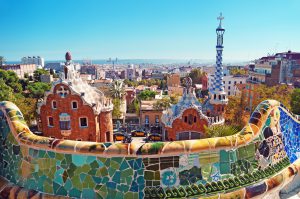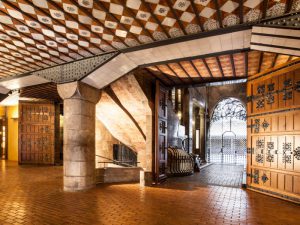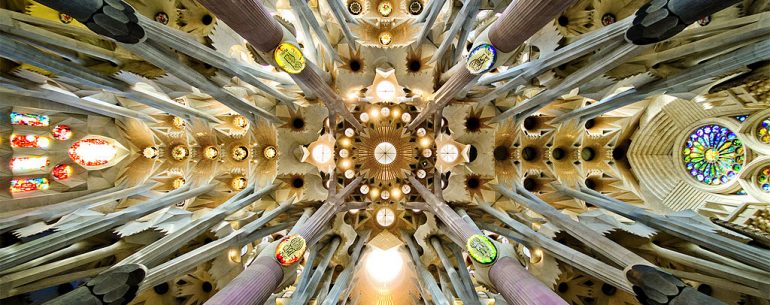As you probably already know, Barcelona is one of the most unique and beautiful cities in Spain. Being part of Catalonia, it has a distinctive language, cultural background, cuisine and a large handful of incredible landmarks, nine of which are UNESCO world heritage sites.
UNESCO stands for ‘United Nations Educational, Scientific and Cultural Organisation’. This organisation was established in 1945 by the United Nations with the aim of building peace, reducing poverty, promoting sustainable development and protecting cultural and natural heritage.
Annually, UNESCO collates a World Heritage List to recognise unique landmarks as having cultural, historical, scientific or another form of significance, and these are legally protected by international treaties. Spain is home to a whopping 46 UNESCO World Heritage Sites, and is the country with the 3rd largest amount of sites in the world, after Italy and China. Barcelona is lucky enough to be blessed with an astonishing 9 of these recognised sites!
Whether you’re an architecture expert or just want to see some of the most amazing constructions in the world, these beautiful buildings by Catalan Modernist architects Domènech i Montaner and Antoni Gaudí, are well worth stopping by for a visit when in Barcelona.
 1. Park Güell
1. Park Güell
UNESCO World Heritage Site since: 1984
A trip to Park Güell offers a serene escape from the bustling city centre, as well as an in-depth look at the signature styles of this famed architect. From the moment you enter the park it is evident that you have stepped into Gaudí territory, due to the exciting spectrum of coloured mosaics, unusually shaped rooftops and an overall naturalist feel.
Of course, a trip to Park Güell is incomplete without a visit to see the famous multicoloured salamander, popularly known as ‘el drac’ (the dragon). Situated at the entrance of the park, this magnificent monument is a brilliant display of Gaudí’s signature mosaic style. The distinctive method he uses, known as ‘trencadís’, can be described as joining together bits of broken tiles, dishes and glass to create astonishing art, and Park Güell is a true homage to these unique designs.
The focal point of this UNESCO World Heritage Site is the main terrace from where breathtaking views of the city await you. We recommend buying your tickets in advance, as they have pre-allocated times and allow access to the Monumental Core only within the first 30 minutes after the designated start time. Park Güell offers a relaxing way to unwind as you look out over the beautiful cityscape, the Mediterranean sea and of course, the vivid designs that surround you!
For ticket prices and opening times, see Park Güell’s official website.
Address: Carrer d’Olot 5, 08024 Barcelona
 2. Palau Güell
2. Palau Güell
UNESCO World Heritage Site since: 1984
Located just off Las Ramblas, the luxurious Palau Güell is one of the earliest works of Antoni Gaudí as well as being one of the most magnificent buildings of the ‘Art Noveau’ movement. Originally designed to be a building of many purposes with exposition rooms, event rooms, and apartments, the Palau contains sleeping quarters on the lower level and even a ramp for horses leading to the stables in the basement.
Situated on Carrer Nou de la Rambla, one of the most emblematic in the Raval neighbourhood, the building was the home of the Güell i López family until they moved to Park Güell. Gaudí designed a functional palace in order to adapt to the family’s needs in both their private life and the intense cultural and social life they led. The choice of location is slightly unusual, as a large proportion of the bourgeoisie were setting up home in the new and upcoming Eixample district. Due to this, the building’s Modernist-style façade truly stands out and contrasts with the smaller, more simple houses in the neighbourhood.
Palau Güell is built with stone coated with marble and decorated with hand carved wood and iron and is a magnificent example of the early days of Gaudí’s fevered architectural imagination. Pay extra close attention to the magnificent iron detailings that decorate the entrance! The building was inaugurated during the World Fair Exhibition in 1888, and many social functions were hosted here. It also forms part of the Raval Cultural project, an initiative that aims to provide everyone with access to the neighbourhood’s artistic and cultural heritage. Although this is a lesser-known Gaudí landmark, it is most certainly worth visiting when in Barcelona. Additionally, the surrounding Raval area is renowned for its restaurant scene, so you can grab a bite to eat after a long day of exploring Gaudí’s infamous work!
For ticket prices and opening times, see Palau Güell’s official website.
Address: Carrer Nou de la Rambla 3-5, 08001 Barcelona
3. Casa Milà (La Pedrera)
UNESCO World Heritage Site since: 1984
Casa Milà, better known as La Pedrera, is one of the fantastic buildings constructed in the early 20th Century and is another one of Gaudí’s earlier works. With not a single wall inside built perfectly straight, Casa Milà is a unique place to experience Gaudí’s inspiring creations. This unique landmark is located on the famous Passeig de Gràcia, near to another of Gaudí’s great works, Casa Batlló.
The building was once the mansion of wealthy business man, Pere Milà i Camps, who commissioned Gaudí to design his family’s house in 1906. It was later nicknamed La Pedrera, meaning “the quarry”, because of its rough, open quarry-like appearance. Today, La Pedrera is the headquarters of the Fundació CatalunyaCaixa and is also used as a cultural centre which organises many events, art exhibitions and tours throughout the building itself, as well as the city of Barcelona.
This UNESCO World Heritage Site was the last residential building designed by Gaudí and is one of the finest examples of the legacy he left to the city, as well as being one of the most important buildings of the 20th century. Fun fact: Gaudí intentionally designed the building with lifts on every second floor, rather than every floor, in order to encourage friendly encounters in the stairwells and landing!
Try not to miss out on taking a walk on the terrace to see his soldier-shaped chimneys up close. With Gaudí’s unique style and vivid colours displayed throughout, La Pedrera is certainly a sight worth seeing when visiting Barcelona.
For ticket prices and opening times, see La Pedrera’s official website.
Address: Carrer de Provença, 261-265, 08008 Barcelona
4. Casa Vicens
UNESCO World Heritage Site since: 2005
As Gaudí’s first major commission in Barcelona, but possibly the least well-known, Casa Vicens is a private residence located in the Gràcia district. Gaudí planned out Casa Vicens between 1883 and 1885 for its first owner, Manel Vicens i Montaner, who hired the young architect (just in his thirties) to conjure up his first house in Barcelona. He was specifically commissioned to design a summer house for Vicens i Montaner in the trendy Gràcia district, and this he most certainly did! A fantastically lush garden with waterfalls and fountains first adorned the outdoors, while the exterior and interior walls of the Casa were decorated with nature-inspired motifs.
Gaudí created an innovative and original project that deviated completely from the style of anything else built in Catalonia up to that point. The magnificently unique structure is characterised by intense, bright colours (mostly green, red and white) and floral patterned tiling with yellow blooms and bulbs. The home was built with red-coloured bricks, undressed stone, and vivid ceramic tiles, using Oriental and Eastern styles as inspiration. The style of Casa Vicens is a reflection of Neo-Mudéjar architecture, a popular style that can be seen throughout Gaudí’s other works.
Casa Vicens opened its doors as a museum to the public in November 2017, so make sure you check it out to see the interior of this incredible building!
For ticket prices and opening times, see Casa Vicens’ official website.
Address: Carrer de les Carolines, 20, 08012 Barcelona
5. Sagrada Família
UNESCO World Heritage Site since: 2005
The Sagrada Família is arguably the most incredible structure in Barcelona, not only for its size, design and intricate modernist features, but also due to the fact that it has been in construction for over 130 years – longer than the Egyptian Pyramids took to build!
Interestingly, the Sagrada Família is an expiatory church, meaning worshippers go here to ask for forgiveness for their sins. Funded completely by donations, the church currently has 8 towers, but by the end of construction the church will have a total of 18 towers with 12 representing the 12 apostles, 4 representing the 4 evangelists, 1 representing the Virgin Mary, and the tallest and most central tower will represent Jesus. As you stroll around the building you can truly appreciate Gaudí’s use of colours, especially when looking at the pinnacles at the top of the towers that are decorated with colourful mosaics.
The interior of the Sagrada Família is equally as breathtaking as its exterior, with detailed ceilings that can be described as resembling a kaleidoscope! Gaudí disliked straight lines, as they don’t occur naturally, and instead preferred curves, texture, and shapes. He once quoted that ‘nothing is art if it doesn’t come from nature’, and when you enter the basílica and look up, the columns undeniably resemble trees with branches!
There may be a long queue to enter the church, but you will be able to see the new sections added and it’s definitely worth the wait! Alternatively, you can relax on the grass and enjoy the view in one of the two adjoining parks. Although there is no exact set date for the completion of the construction of the Sagrada Família, it is currently estimated that it will be finished around 2026, 100 years after Gaudí’s death.
A trip to Barcelona is truly incomplete without a visit to the iconic Sagrada Família… everybody knows that!
For ticket prices and opening times, see the Sagrada Família’s official website.
Address: Carrer de la Marina 41, 08013 Barcelona
6. Casa Batlló
UNESCO World Heritage Site since: 2005
This grand house exhibits intelligence, creativity, and diversity. Situated on the famous Passeig de Gràcia next to Casa Amatller, Casa Batlló was opened to the public in 2002, just 16 years ago. This UNESCO World Heritage Site is characterised by its skeletal structure, colourful façade and curved roof, adorned with tiles that resemble the scales of a reptile, making it unlike anything else you will see in the city.
Casa Batlló’s structure gives the building a local nickname of ‘Casa dels ossos’ (House of bones) due to its very original architecture: the balconies resemble fragments of skull with openings for the eyes and nose. The columns on the first-floor take the shape of human bones and many other details of the facade resemble a skeleton – a truly unique building!
It is hard to assume what inspired Gaudí because he was always thinking outside of the box, but it is evident that this house was meant to feel alive and was once again, based upon nature. From the cosy mushroom fireplace, to the loft ceiling resembling a ribcage, it is easy to see that the famous architect loved to replicate the beauty of life. Many people also believe that the colourful metallic tiles in Casa Batlló and rigid arches of the roof are meant to represent the legendary dragon of Patron Saint Sant Jordí.
Don’t miss this remarkable landmark on your visit to the Catalan capital!
For ticket prices and opening times, see Casa Batlló’s official website.
Address: Passeig de Gràcia 43, 08007 Barcelona
7. The Crypt of Colonia Güell
UNESCO World Heritage Site since: 2005
Gaudí’s patron, Eusebi Güell, imagined creating an industrialised colony that would be able to support the lives of his workers and their families. A place for education, a church, and a recreational area were all accounted for. The Güell Crypt was intended to be Gaudí’s experiment for his architectural innovations that he would later apply to Sagrada Família. Like in any architect’s perfect dream, Gaudi was given total freedom and unlimited budget to build the church. He seized the opportunity and developed extensive plans for a magnificent Modernist church, with his trademark non-linear columns, characteristic archways and decorative elements.
Gaudí’s original plans, which can be seen in the nearby visitor’s centre, included two naves and a 40m high central dome. Funds dried up and in 1914 the project was left unfinished. However, the completed crypt is truly spectacular, with breathtaking stained glass windows, and intricate ceramic mosaics like those in the Park Güell.
However, it must be mentioned that Colonia Güell isn’t actually located in the city centre, but in a picturesque town 23km South-west of Barcelona called Santa Coloma de Cervelló.
For ticket prices and opening times, see Colonia Güell’s official website.
Address: Carrer Claudi Güell 6, 08690 Santa Coloma de Cervelló
8. Palau de la Música Catalana
UNESCO World Heritage Site since: 1997
Making your way through the narrow streets of El Born you may stumble across the Palau de la Música Catalana. From the outside alone it is an impressive building with its old and new sections sitting side by side in perfect harmony. It provides a wonderful contrast to the simpler buildings surrounding it, and it most certainly stands out amongst these. It is easy to understand why the Catalan people take pride in this building and describe it as representative of their open minded and forward thinking spirit.
Designed by talented architect Lluís Domènech i Montaner, the Palau de la Música Catalana is an architectural jewel of Catalan Art Nouveau, and is the only concert venue in this style to be listed as a UNESCO World Heritage Site. The largest and most well-known space in the Palau is the Concert Hall. This is a 2,146 seat venue with an ornate glass roof – the main setting for concerts and recitals. It was designed as a home for Barcelona’s choir, the Orfeó Catalá. The amateur choir still perform at the venue today.
Make sure you take the time to look up when you enter the grand concert hall to admire the incredibly detailed glass ceiling, it’s certainly a sight not worth missing!
For ticket prices and opening times, see the Palau de la Música Catalana’s official website.
Address: Carrer del Palau de la Música, 4-6, 08003 Barcelona
9. Hospital de Sant Pau
Situated on the border of Eixample and the El Guidarnó district of Barcelona, the Hospital de Sant Pau is a complex built between 1901 and 1930, designed by Catalan art-noveau architect Domènech i Montaner, the genius also behind the grand architecture of the Palau de la Música Catalana. It was a fully functioning hospital until June 2009, but today is an icon among Barcelona’s dazzling array of landmarks. The breathtaking garden, mosaics and artwork make a visit to this architectural marvel an absolute must when visiting the city.
The complex consists of 27 red brick pavilions with colourful, ceramic roofs, but its most emblematic part is the huge entrance building that homes the iconic clock tower. A visit to this incredible collection of buildings allows you to dive into history, art and of course, architecture. There is an exhibition space that takes you on a journey through the history of medicine in Barcelona as you embark on an adventure into one of Europe’s oldest healthcare institutions. The exhibition explains how the hospital was run in its early days, the kind of medicine that was used there, and what 20th century Barcelona was like – worth a visit if not for the architecture, but for the history lesson as well!
For ticket prices and opening times, see the Hospital de Sant Pau’s official website.
Address: Carrer de Sant Quintí 89, 08041 Barcelona




Leave a Reply